
The Silvretta Alps are a mountain range of the Central Eastern Alps shared by Tirol, Vorarlberg and Graubünden (Switzerland). The Austrian states of Tirol and Vorarlberg are connected by a pass road. The majority of the peaks are elevated above three thousand metres and are surrounded by glaciers. Thus, the area is also known as the "Blue Silvretta".
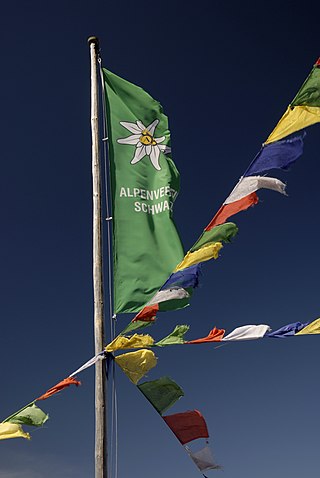
The Austrian Alpine Club has about 573,000 members in 196 sections and is the largest mountaineering organisation in Austria. It is responsible for the upkeep of over 234 alpine huts in Austria and neighbouring countries. It also maintains over 26,000 kilometres of footpaths, and produces detailed maps of key mountain areas within Austria. Much of this work is done by the association's 22,000 volunteers. The association has a museum in Innsbruck dedicated to the history of alpinism. It also has sections in Belgium and the United Kingdom, and a group in Poland.

The Swiss Alpine Club is the largest mountaineering club in Switzerland. It was founded in 1863 in Olten and it is now composed of 111 sections with 160,000 members (2020). These include the Association of British Members of the Swiss Alpine Club.
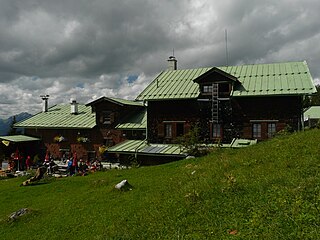
The Vorderkaiserfelden Hut is an alpine hut in the Kufstein district, Austria. It is located at 1,384 metres (4,541 ft) on the southwest slope of the Zahmer Kaiser below the Naunspitze and high above the Kaisertal valley in the Kaisergebirge mountain range. It has a good view over the Inn valley and Kufstein and across to the Mangfall Mountains and the Wilder Kaiser.

The South Tyrol Alpine Club, abbreviated AVS, is an association of German and Ladin-speaking mountain climbers in South Tyrol, northern Italy. Founded in 1946, it is subdivided into 32 sections and 58 local divisions. The AVS is based in Bolzano and has more than 60,000 members.
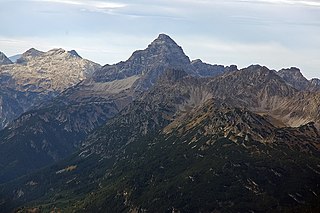
The Hochvogel is a 2,592-metre-high (8,504 ft) mountain in the Allgäu Alps. The national border between Germany and Austria runs over the summit. Although only the thirteenth highest summit in the Allgäu Alps, the Hochvogel dominates other parts of Allgäu Alps and the other ranges in the immediate neighbourhood. This is due to the fact that the majority of the higher peaks are concentrated in the central and western part of the Allgäu Alps. The Hochvogel stands on its own in the eastern part of the mountain group; the nearest neighbouring summits are 200 to 300 metres lower. Experienced climbers can ascend the summit on two marked routes.

The German and Austrian Alpine Club was a merger of the German, Austrian and German Bohemian Alpine Club that existed from 1873 to 1938.
The Alpine Club Guides were the standard series of Alpine climbing guidebooks that cover all the important mountain groups in the Eastern Alps. They were produced jointly by the German (DAV), Austrian (ÖAV) and South Tyrol Alpine Clubs (AVS). They had been published since 1950 by the firm of Bergverlag Rother in Munich, Germany.

The Hans Berger Haus is a refuge hut belonging to the Kufstein section of the Austrian Friends of Nature, located in the Kaisergebirge mountains in Tyrol. The tenants run a well-known climbing school here.

The Fritz Pflaum Hut is an Alpine club hut belonging to the Bayerland Section of the German Alpine Club, located in the Kaisergebirge mountains in the Austrian federal state of Tyrol.
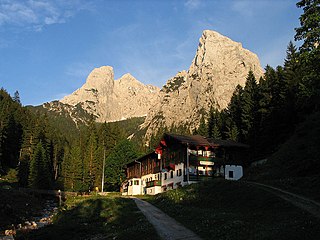
The Anton Karg Haus, formerly the Neue Hinterbärenbad Hut, is an Alpine club hut belonging to the Kufstein Section of the Austrian Alpine Club in the Kaisergebirge mountains in the Austrian state of Tyrol. The hut is named after the co-founder of the Kufstein Section, Anton Karg, who was the manager of the hut from 1888 and, from 1890 to 1919, the chairman of the Kufstein Branch of the Alpine Club.

The Münchner Haus on Germany's highest mountain, the Zugspitze, is an Alpine Club hut belonging to the Munich Section of the German Alpine Club (DAV).

The Knorr Hut is a mountain hut belonging to the German Alpine Club and located in the Wetterstein Mountains at a height of 2,052 m. Its lies right on the edge of the Zugspitzplatt where it drops into the Reintalanger in a location with scenic views and is an important base for hikers who can climb up to it on the normal route from the town of Garmisch-Partenkirchen through the Reintal valley to Germany's highest mountain, the Zugspitze.
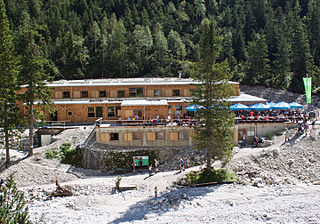
The Höllentalanger Hut is a managed hut owned by the German Alpine Club in the Wetterstein Mountains of Bavaria, in the district of Garmisch-Partenkirchen. The hut lies in a narrow defile between the Höllental-Blassen and Waxenstein-Riffelwand crest and is open from the end of May to mid-October. It has more than 80 bedspaces.

The Bregenz Forest Mountains, also the Bregenzerwald Mountains, are a range of the Northern Limestone Alps and Eastern Alps, named after the town of Bregenz. The Bregenz Forest Mountains are located entirely in the Austrian state of Vorarlberg.

The Laufen Hut sits at an elevation of 1,726 metres (5,663 ft) in the Tennengebirge at the foot of the Fritzerkogel mountain in the Austrian state of Salzburg. The Fritzerkogel, with an elevation of 2,360 metres (7,740 ft), is one of the higher peaks in the Tennen Mountains in the northern Limestone Alps. The Laufen Alpine club hut is operated as a self-service facility as a major base for numerous climbing routes, circular routes and crossings, as well as hiking on the plateau of the Tennengebirge, and ski touring.
Willi (Willie) Huttig was a German photographer and alpinist.

The Wangenitzsee Hut is a mountain hut in Hohe Tauern National Park, in Carinthia, Austria. It is situated directly on the Wangenitzsee, the largest lake of the Schober group of the Eastern Alps. At an altitude of 2,508 metres (8,228 ft) above sea level (AA), it is the highest hut in the Schober group. Depending on the weather, it opens in the middle of June and closes at the end of September. It is located on the Wiener Höhenweg, and is supplied by a material ropeway from the Debanttal.

The Lizumer Hütte is an Alpine club hut of the Hall in Tirol section of the Austrian Alpine Club in the Tux Alps in the Austrian state of Tyrol. The hut is located in the rear Wattental in the middle of the extensive ski touring and hiking area of the Wattentaler Lizum. Due to its location and size, the hut is also used for a wide variety of alpine courses and seminars.



















